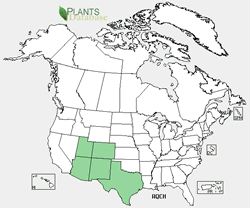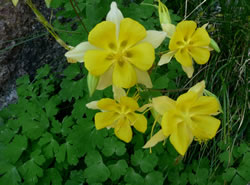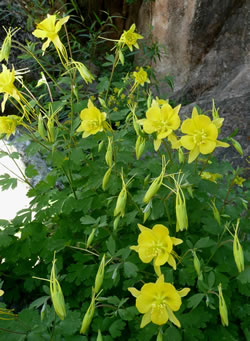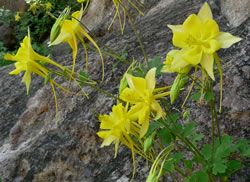Plant of the Week
 Aquilegia chrysantha range map. USDA PLANTS Database.
Aquilegia chrysantha range map. USDA PLANTS Database.
 This golden columbine photo was taken in the Pajarita Wilderness on the Coronado National Forest in Arizona. Plants thrive in this Sonoran Desert canyon despite summer temperatures that exceed 100 degrees for many months. Photo by Charlie McDonald.
This golden columbine photo was taken in the Pajarita Wilderness on the Coronado National Forest in Arizona. Plants thrive in this Sonoran Desert canyon despite summer temperatures that exceed 100 degrees for many months. Photo by Charlie McDonald.
 Flowers hang down in bud, but turn upright when the flowers open. The flowers are held well above the foliage where pollinators can easily find them. Photo by Charlie McDonald.
Flowers hang down in bud, but turn upright when the flowers open. The flowers are held well above the foliage where pollinators can easily find them. Photo by Charlie McDonald.
 The long petal spurs and upright flowers of golden columbine are adaptations for hawk moth pollination. Photo by Charlie McDonald.
The long petal spurs and upright flowers of golden columbine are adaptations for hawk moth pollination. Photo by Charlie McDonald.
Golden Columbine (Aquilegia chrysantha)
By Charlie McDonald
Columbines (Aquilegia species) are spectacular plants found in woodlands and mountains throughout North America and golden columbines (Aquilegia chrysantha), which grow in the Southwest, are one of the most spectacular species in the group. They have bright yellow to golden-yellow flowers up to 3 inches in diameter with flower stalks that project well above the foliage. The flowers are nodding in bud, but turn upright when the flowers open. The leaves are multiply divided into threes (ternate) that terminate in delicate emerald green leaflets. Plants are 1 to 3 feet tall.
The golden columbine is the most widespread of the pure yellow-flowered columbines of the Southwest. The other yellow-flowered columbines, which include longspur columbine, Chapline’s columbine, Hinckley’s columbine, and Rydberg’s columbine, are all more rare and restricted. Botanists disagree about how these plants should be classified. They may be treated as distinct species, as varieties, or given no recognition at all depending on the opinion of the particular botanical expert.
Golden columbines grow in moist canyons and around spring seeps in southwestern mountain ranges. They prefer shade, but can tolerate a considerable amount of sun and heat. They can also tolerate some degree of drought. As a result, they are widely used as ornamentals in southwestern gardens where they are prized for their showy flowers, relatively long blooming period, and rich emerald green foliage. They are grown from seed and will readily reseed in good garden soils. Seeds and plants are available from a variety of sources.
